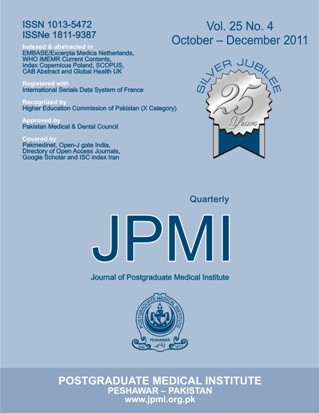FAMILY PLANNING METHODS AND GENDER DISTRIBUTION OF CHILDREN IN A DEFINED RURAL COMMUNITY OF PESHAWAR
Main Article Content
Abstract
Objectives: To determine frequency of different family planning methods in rural community of Peshawar
and to determine gender composition of children in women practicing family planning.
Methodology: Data was collected from family planning program started with health education and
motivation in the model community of Pakistan Medical Research Council at the village Budhni, Peshawar.
The family planning method along with age of women, numbers of male and female children were
recorded.
Results: Injection was a method of choice used by majority (59%) of the women. Most of the women 157
(28.3 %) started family planning practice were in the age group of 26-30 years. Number of women having
up to 04 children was greater (54.4%) than women (45.6%) having more than 04 children. Most (54%) of
them had two male children at the time of starting of family planning. Out of 40 women with one child,
70% had one male child and 30% had a female child.
Conclusion: Women having more male children were more likely to adopt family planning practices.
Article Details
Work published in JPMI is licensed under a
Creative Commons Attribution-NonCommercial 2.0 Generic License.
Authors are permitted and encouraged to post their work online (e.g., in institutional repositories or on their website) prior to and during the submission process, as it can lead to productive exchanges, as well as earlier and greater citation of published work.


